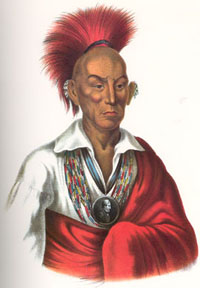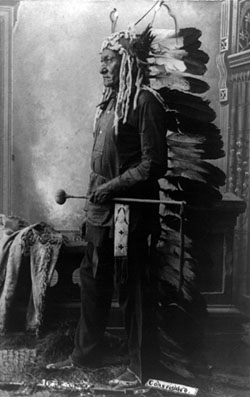Famous Native Americans

Chief Black Hawk of the Sauk Indians
Throughout Native American History there have been many famous Native Americans. Many Native Americans are famous for standing up for their own ideals and religion and not letting the Europeans change the way thought. This cost many Native American Indians their lives because the Europeans forced the American Indians from their own lands when they started to spread out across the plains of America.
Black Hawk is a famous Native American for standing up to the Americans who fought to take land from his Indian tribe, the Sauk Indians. Black Hawk became the Indian Chief of the Sauk Indians after the passing of Chief Pyesa. Black Hawk was a fierce warrior starting when he was still too young to fight along side other tribesmen. In 1804 Black Hawk was in Canada, seeking out gunpowder to help the Sauk Indians to fight against their enemies. During the war of 1812, President James Madison promised Black Hawk and his tribe gunpowder if they agreed to not help the English. Black Hawk agreed to this, but when he went to the fort to get the gunpowder, he returned with only tobacco, food and blankets.
In May of 1816 Black Hawk signed a peace treaty with the Americans, not knowing he was also signing away the Sauk lands east of the Mississippi. Later in 1831 Black Hawk and the Sauk Indians were forced to move from their lands and live on an Indian reservation in Iowa. Black Hawk fought against the Americans for the lands his tribe owned, but in the end he surrendered to the Americans.

Sitting Bull is another of the famous Native Americans, who was a member of the Sioux Indian tribe. Sitting Bull was name “Slow” before his father gave him his warriors name after a battle where he raced ahead of the other warriors in a battle against the Crow Indians. The Sioux Indians lived on the plains of the Dakotas. After a battle with the Crow Indians, in which Sitting Bull was badly wounded, but continued to fight, he was made the chief of the Strong Hearts warrior society. During the next years many Sioux natives traveled north away from the white men. Sitting Bull welcomed his fellow tribesmen and shared food, clothing and teepees to shelter them. It wasn’t until 1867 when the Sioux nation decided upon one Chief and they chose Sitting Bull to lead them. During this ritual Sitting Bull was given an Indian Headdress of eagle feathers, representing the brave deeds done by the bravest warriors.
Sitting Bull signed a treaty to protect the Black Hills and keep the native land of the Sioux nation. This treaty held until 6 years after gold was found in the Black Hills. With the new found gold came white men and miners to claim the gold for themselves. When the white men came to defeat the Sioux and Sitting Bull, they were defeated. After this Sitting Bull chose to move his tribe to Little Big Horn River, where they were again attacked by white men, led by Colonel George A. Cluster. The Sioux Indians quickly defeated them also but found themselves searching for food that could not be found. In this time of need, Sitting Bull led the Hunkpapas Indians north to Canada. The conditions in Canada were poor and they still could not find enough food. In 1878 a messenger was sent to Canada from the American government, promising the Indians peace, food and reservations to live on. At this time Sitting Bull agreed to the treaty and surrendered himself at Fort Buford in North Dakota. Even still the Indians did not receive the food and shelter they were promised and were still suffering in the Standing Rock Reservation.
In December of 1890 James McLaughlin sent a party of Indian soldiers to bring Sitting Bull back. The raid resulted in the death of Sitting Bull and 13 other Indians. With the death of Sitting Bull, the Indians’ way of life soon faded.
